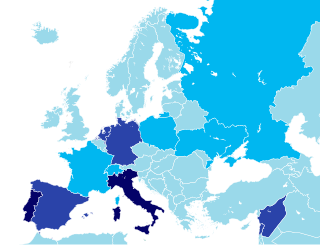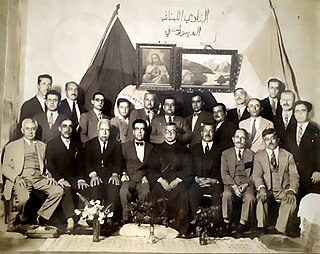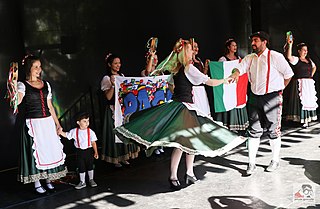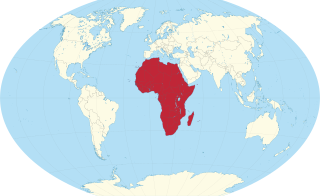
The German diaspora consists of German people and their descendants who live outside of Germany. The term is used in particular to refer to the aspects of migration of German speakers from Central Europe to different countries around the world. This definition describes the "German" term as a sociolinguistic group as opposed to the national one since the emigrant groups came from different regions with diverse cultural practices and different varieties of German. For instance, the Alsatians and Hessians were often simply called "Germans" once they set foot in their new homelands.

Japanese Brazilians are Brazilian citizens who are nationals or naturals of Japanese ancestry or Japanese immigrants living in Brazil or Japanese people of Brazilian ancestry.

The Portuguese people are a Romance-speaking ethnic group and nation indigenous to Portugal, a country in the west of the Iberian Peninsula in the south-west of Europe, who share a common culture, ancestry and language.

German Brazilians refers to Brazilians of full or partial German ancestry. German Brazilians live mostly in the country's South Region, with a smaller but still significant percentage living in Southeast Region.
This article details the geographical distribution of speakers of the German language, regardless of the legislative status within the countries where it is spoken. In addition to the Germanosphere in Europe, German-speaking minorities are present in many other countries and on all six inhabited continents.

Immigration to Brazil is the movement to Brazil of foreign peoples to reside permanently. It should not be confused with the forcible bringing of people from Africa as slaves. Latin Europe accounted for four-fifths of the arrivals. This engendered a strikingly multicultural society. Yet over a few generations, Brazil absorbed these new populations in a manner that resembles the experience of the rest of the New World.

The labor force in Japan numbered 65.9 million people in 2010, which was 59.6% of the population of 15 years old and older, and amongst them, 62.57 million people were employed, whereas 3.34 million people were unemployed which made the unemployment rate 5.1%. The structure of Japan's labor market experienced gradual change in the late 1980s and continued this trend throughout the 1990s. The structure of the labor market is affected by: 1) shrinking population, 2) replacement of postwar baby boom generation, 3) increasing numbers of women in the labor force, and 4) workers' rising education level. Also, an increase in the number of foreign nationals in the labor force is foreseen.

Arab Brazilians are Brazilian citizens of Arab ethnic, cultural, linguistic heritage and identity. The majority of Arab Brazilians trace their origin to the Levantine region of the Arab World, known in Arabic as Bilad al-Sham, primarily from Lebanon and Syria, as well as Palestine. Arab Brazilians are Christians in the great majority. The first Syrians and Lebanese arrived in São Paulo around 1880. It is not known exactly when, although the Syrians and Lebanese say that in 1885 there was a small core of peddlers working in the market square. By 1920, the census listed 50,246 Syrians and Lebanese in Brazil, 38.4% (2/5) of these in the state of São Paulo. The 1940 census enumerated 48,614 Syrians, Lebanese and other related groups with a decrease of approximately 1647 people. As immigration almost ceased after 1929 and the colony aged, it is surprising that the decline was not even greater. The trend of the period between 1920 and 1940 was the continuous concentration of Syrians and Lebanese in São Paulo. Almost half (49.3%) of Syrians and Lebanese residents in Brazil lived in São Paulo.
There is a significant community of Brazilians in Japan, consisting largely but not exclusively of Brazilians of Japanese descent. Brazilians with Japanese descent are known as Nikkei Brazilians. They constitute the largest number of native Portuguese speakers in Asia, greater than those of formerly Portuguese East Timor, Macao and Goa combined. Likewise, Brazil maintains its status as home to the largest Japanese community outside Japan.
Korean Brazilians are Brazilians of full, partial or predominantly Korean ancestry or a Korean-born person residing in Brazil. The Korean population in Brazil, the largest in Latin America, is about 50,000.

Russian Brazilians are Brazilian citizens of full or partial Russian ethnic background or Russian-born people residing in Brazil. The term can also refer to someone with a Brazilian mother and Russian father, or vice versa.

Lebanese Brazilians, are Brazilians of full or partial Lebanese ancestry, including Lebanese-born immigrants to Brazil. According to the Brazilian Institute of Geography and Statistics, they form some of the largest Asian communities in the country, along with other West Asian and East Asian descendants.

As of December 2022, Portugal had 1,683,829 inhabitants that were born in a foreign country, out of 10,467,366 inhabitants, accounting for 16.1% of its total population.

Croatian Brazilians are Brazilians of full, partial, or predominantly Croat descent, or Croat-born people residing in Brazil.
Salvadoran Australians are Australians of Salvadoran descent. Salvadoran immigration to Australia was caused principally by economic and political turmoil in El Salvador.

Brazil had an official resident population of 203 million in 2022, according to IBGE. Brazil is the seventh most populous country in the world, and the second most populous in the Americas and Western Hemisphere.
Brazilian Australians refers to Australian citizens of Brazilian birth or descent.

Italian Brazilians are Brazilians of full or partial Italian descent, whose ancestors were Italians who emigrated to Brazil during the Italian diaspora, or more recent Italian-born people who've settled in Brazil. Italian Brazilians are the largest number of people with full or partial Italian ancestry outside Italy, with São Paulo being the most populous city with Italian ancestry in the world. Nowadays, it is possible to find millions of descendants of Italians, from the southeastern state of Minas Gerais to the southernmost state of Rio Grande do Sul, with the majority living in São Paulo state. Small southern Brazilian towns, such as Nova Veneza, have as much as 95% of their population of Italian descent.

During the period of 1965 - 2021, an estimated 440,000 people per year emigrated from Africa; a total number of 17 million migrants within Africa was estimated for 2005. The figure of 0.44 million African emigrants per year pales in comparison to the annual population growth of about 2.6%, indicating that only about 2% of Africa's population growth is compensated for by emigration.
Portuguese in France (Luso-French) refers to people from Portugal who immigrated to or reside in France or French citizens of Portuguese descent.


















